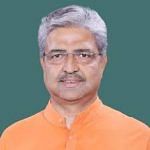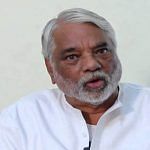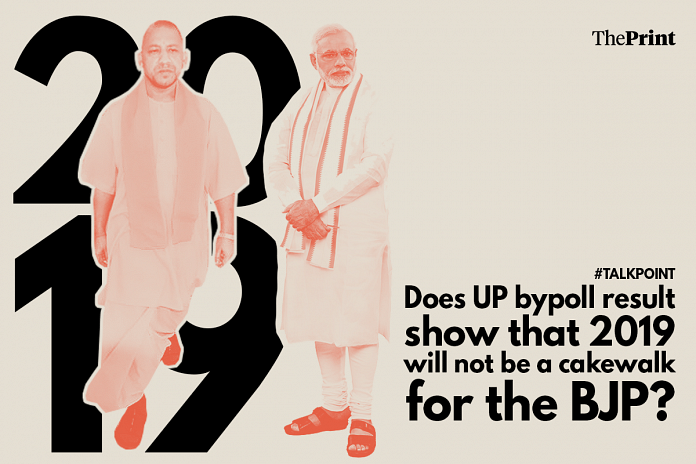The BJP has lost three closely watched bypolls, two in in Uttar Pradesh — Gorakhpur, Phulpur — and one in Bihar, Araria. The party has won from Gorakhpur since 1991, with five consecutive wins for chief minister Yogi Adityanath.
ThePrint asks: Does the UP bypoll result show that 2019 will not be a cakewalk for the BJP?
Our overconfidence has given us a rude shock
 Bhartendra Singh
Bhartendra Singh
BJP MP, Bijnor, Uttar Pradesh
The BJP marched a long and tedious path to achieve the overwhelming results of the 2014 Lok Sabha elections. India’s most populous state Uttar Pradesh reiterated the BJP workers’ belief in the party ideology and leadership in the 2017 Vidhan Sabha elections. The results illustrated that the hard task of preaching nationalism in a poor and diverse country had come of age.
But a political worker never has the luxury to bask in his achievements. The low voter turnout (37.39 per cent) in last week’s bypolls reflects the complacency of both the BJP workers and voters. Our forte of vigour and coordination of karyakartas, voters and leaders seems missing. Although the result has no bearing on the stability of the state government, our overconfidence has given us a rude shock.
The BSP has a tradition and policy of not involving themselves in byelections. Mayawati’s support to her political foes changed the vote arithmetic in the UP by-elections of 2018. The sad and dangerous politics of ‘BJP vs others’ and ‘Hindu vs others’ seems to be the current opposition norm. It was shamelessly showcased by Rahul Gandhi in Gujarat. The positive campaign of a strong nation based on long-term development and fiscal reform needs resilient public support.
The BJP won from Pandit Nehru’s bastion (Phulpur) for the first time in 2014. The Congress has lost its voters, making them trail Atiq Ahmad (securing 46,919 votes), the mafia don and independent candidate who came third. In UP, the Congress only won two seats out of 80 (Sonia and Rahul Gandhi) in the Lok Sabha 2014 elections. The party marginalised to a minimal, I wonder at the reason for their festivities over the byelection results.
Phulpur representative Keshav Prashad Maurya was promoted to the position of president of the state organisation and soon made deputy chief minister of UP. Development projects worth Rs 6,000 crore have been unveiled by the leader for his electorate. Even in this fortunate constituency, development works have their slow pace of implementation as compared to the quick yields of divisive politics that plays up minority insecurities and caste issues.
At a dinner, noted industrialist Gautam Thapar congratulated me for the courage the Modi government had displayed in administering the long-term measures of demonetisation and GST. He wondered if the instant knee-jerk reaction of the voters and party gains had been considered. For the BJP, the national gain outweighs party interest. We shall continue treading the tough path of nationalism against the politics of caste and minority insecurities.
UP bypoll results show people’s discontent is deeper than what is visible
 Kancharla Keshava Rao
Kancharla Keshava Rao
MP, TRS
The direction that the results have taken not only in UP but also in the neighbouring state of Bihar shows that the BJP has completely struck out. This is a testament to the fact that discontent among the people is deeper than is visible.
That this will have an effect on the results of 2019 is but natural. Gorakhpur was the constituency of Yogi Adityanath. He retained his seat for nearly 30 years. Now if they have lost the constituency of the chief minister himself, it only goes to show that people are not happy with the BJP leadership. Yogi has lost the special space he held in his constituents’ hearts.
The BJP must introspect as to why things have taken a turn for the worse. Meanwhile, others parties, like the ones who have won there, can together capitalise on the momentum they have gained.
The combination of the SCs, the OBCs and the Muslims is what has brought down the BJP in UP. They are making a statement that they cannot be ignored, cannot be brushed aside. The minorities have felt the brunt of the government for a while now. They are now talking back.
Power arrogance is one of the main reasons the BJP has failed. Both the top and the lower leadership took Gorakhpur for granted and have been taught a lesson.
This is an important underpinning and its waves will be felt across the country.
UP results are a lesson to the opposition to be united
 Sanjay Nirupam
Sanjay Nirupam
President, Mumbai regional Congress Committee
Wednesday’s bypoll results, particularly in UP, seem to hold the lesson that the opposition will have to be united for the upcoming 2019 or late-2018 elections.
It is important to note that the BJP won 2014 with a 31 per cent vote share. As many as 69 per cent of the votes were cast against the BJP. But this anti-BJP vote was divided among too many parties. They could not unite against the BJP.
The way the SP and the BSP came together in UP is commendable. It is the need of the hour. There is a natural trend that can be seen if we look at the bypolls closely. In Rajasthan, the Congress won. In Madhya Pradesh as well, the BJP lost. If elections take their natural course, then the BJP will lose in 2019, yet again. These bypoll results are a comment on the loss of faith in the Modi government.
The BJP, unlike in other elections, has not been able to practise their customary EVM management. A vote difference of 25,000 is believable, but winning by a margin of two to five lakh seems to be manipulated.
Similarly, a party that wins the state assembly by 300-plus should ideally not suffer bypoll losses for the next couple of years. That makes the assembly election look suspicious.
This week’s result is a vote against the hate politics of the BJP. It is a vote against the rising inflation, corruption, lack of development, and failure on the economic front.
After the UP bypoll losses the BJP needs to restrategise
 Yashwant Deshmukh
Yashwant Deshmukh
Founder-director, CVoter International
What has happened in UP is precisely within 1 per cent of what we had predicted. Given this arithmetic, the people of India have more than once, in Goa, Manipur, Punjab, Rajasthan, Madhya Pradesh and now Uttar Pradesh, shown that they are unhappy with the BJP.
All this looks OK from the opposition’s perspective, but the real question is — are they going to pull their act together before 2019?
What is happening is that the urban turnout has dropped in UP, both in Phulpur and Gorakhpur. In 2004, the urban turnout dropped by 18 per cent and caused the BJP’s defeat. This shows that the middle class, which supports the BJP, may not vote for any other party but can opt to sit out the election completely.
In our Budget tracker, we said this government had a tendency to take the middle class for granted. There was hardly anything for the middle class in the Budget. Inflation is still an issue for most people. They may say that it has come from 10 points in 2013-14 to three now, but that is still 10 points over what it should be. People can’t afford to run their kitchens properly.
That said, Narendra Modi is still immensely popular among the middle class. But he will have to work to convince them to leave their homes and come vote for him. Else it’ll be a repetition of 2004, when Vajpayee couldn’t form the government despite being extremely popular. The only difference will be that the Congress will not secure the same number of votes.
People are losing faith in Modi’s ministers, who have failed to deliver on their mandate. The only ministers with a positive image are Nitin Gadkari, who has made a significant difference in the road and transport sector, and Sushma Swaraj, who enjoys a pro-common man image.
The biggest takeaway of the bypoll is a rejuvenated opposition
 Kumar Anshuman
Kumar Anshuman
Associate Editor
In politics, perception changes overnight. When the results of the assembly elections in Tripura and other northeast states came, it boosted the popular perception that there was no challenge to the BJP in 2019. Just 10 days later, a bypoll result has put a question mark on this perception.
Many may argue that bypolls are not an actual reflection on the government and things will change close to 2019. But the two seats in the UP bypolls were vacated by two MPs who became chief minister and deputy chief minister. This was happening in a state where the BJP had registered a stellar performance, from the 2014 Lok Sabha elections down to the local bodies elections. And one of the seats, Gorakhpur, was the safest seat for the BJP in Uttar Pradesh.
A loss in these bypolls is not a simple arithmetic equation. The impact will have far-reaching consequences. It’s a big mandate in favour of the SP-BSP alliance, which can further disturb the BJP’s calculations. The party was hoping to repeat its performance of 2014 in UP, where the opposition looked scattered till a few days ago. It is true that a lower voter turnout could also be a factor in the Gorakhpur loss, and the party might win the seat again in 2019, when the voter percentage goes up.
But the real damage will take place in areas like western UP, Bundelkhand and Avadh regions, where the BJP is not traditionally stronger. Also, if the voter apathy continues, it will hit the party hard. In such scenarios, the BJP may lose a few seats in UP. The bypoll results in Bihar, too, indicate a backward, Dalit and Muslim consolidation in the opposition. So another shock could come from Bihar.
The biggest takeaway of the bypolls is a rejuvenated opposition. It was looking difficult for all the opposition forces to come together to defeat the BJP. These bypolls have injected some much-needed oxygen into the opposition camp. Now they know they can defeat the BJP. Wait for sometime, and there will be murmurs within the NDA and it is likely they’ll lose a few more partners before 2019.
It’s not an easy task for the opposition to topple a government like this one. But yes, 2019 is not going to be a cakewalk for the BJP and the game is wide open.
Compiled by Deeksha Bharadwaj, Journalist at ThePrint.






